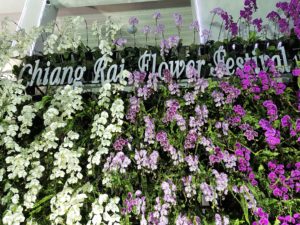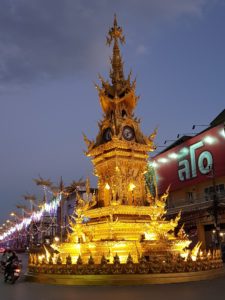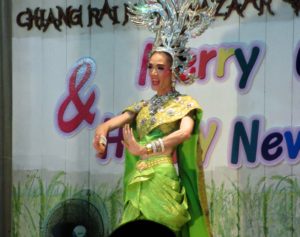During our few days in the Thai city of Chiang Rai, we took in most of the sights either by day or night.
KING MENGRAI MONUMENT
Our tour began at the King Mengrai Monument, situated inauspiciously on an island in the middle of a busy road. An elderly man sat on the floor playing bamboo pipes and people appeared unperturbed by the noise and pollution as they prayed, lit incense sticks and left offerings of flowers. Behind the 3-metre high bronze of the 25th King of Thailand, were three long gold carvings called tung, and in front were numerous large statues of elephants and horses.
We were then hired cycle rickshaws and headed to the Hill Tribe Museum.
HILL TRIBE MUSEUM
The Hill tribe museum is located in a building owned by the Population and Community Development Association (PDA). The hill tribe families were large as they lacked knowledge of birth control or could not afford it. So, as well as selling vegetables at their stalls, the PDA also sold condoms. This developed into a café catchily named ‘Cabbages and Condoms’ which now has branches all over Thailand. A sign proclaimed, ‘Our good food will not cost you a pregnancy’, and condoms are given out instead of sweets at the end of the meal.
In the 3rd floor museum, a 15-minute video provided an excellent overview of the 6 main hill tribes. As visiting hill tribe villages was next on our itinerary, it provided some useful facts and figures.
Karen – Number 440,000 and make up 47% of the hill tribe population. They’re from Burma and are the largest tribe and no longer move around as they used to. They are the only tribe who use elephants and they have their own written and spoken language. Unmarried girls wear white clothing with married women wearing more coloured outfits. Many have been converted to Christianity by missionaries. A sub-tribe is the Padaung whose women use brass coils to elongate their necks to give them swan like beauty. As they’ve been heavily exploited by tourism, most tour operators avoid them, as did ours.
Hmong – (17%) – They’re also from South China and originally had very large families with up to 8 children. The sub groups are blue, black and white and as well as practising shifting cultivation, they grow rice, corn and soya. The women are said to work harder than the men, as they keep the house, look after the children and do farm work, but it’s said they don’t mind. The marriage ceremony involves ‘kidnapping’ their prospective bride.
Lahu – (11%) – They’re originally from Tibet and Southern China and travelled to Thailand through Burma before settling along the river in Chiang Rai where they’re heavily involved in fishing. They have a very varied dress style, with black as the base and often wear towels as head dresses. One sub-group is the Palong who wear several bamboo belts.
Akha – (8%) – They’re from Burma, Laos and China and their villages have a special gate at the entrance, made by the shaman and village men. A new gate is constructed every year and if it is touched, a new one must be made. They live high on the mountains and some still grow opium: the men have the highest rate of opium addiction. They used to believe that having twins was bad luck for the village and that only animals should have multiple births. The mother had to either kill both babies or leave the village and take the twins with her. They have very ornate costumes which often involved head dresses of coins and bird feathers.
Yao – (5%) – They’re from South China and have the most elaborate and beautiful costumes with one outfit taking a year to make. They only marry within their own tribe and have their own written language.
Lisu – (4%) – They’re from China and have two sub groups: black and flowery. The women in this tribe are expert at fishing.
The remaining 8% is made up of smaller groups.
The exhibits were displayed in two small rooms and covered costumes from the tribes and protocols for visiting them. This included showing respect and asking before you take photographs as they believe a photo takes away their soul. Other exhibits were associated with agriculture, hunting and fishing and the now illegal opium trade.
Back in the rickshaws we travelled to the market and bade farewell to our cyclists.
CHIANG RAI MARKET
The covered market was extensive and sold a huge range of items: gifts and decorations for the impending Chinese New Year, clothing, vegetables, meat, fish, and huge bags of lethal red chillies etc. It was not laid out in sections and a small stall displaying smelly fish was next to a stall selling jeans. Birds in small cages along with fish and turtles in buckets were for sale and were intended to be released as in Buddhism this helps you obtain merit.
WAT PRA KAEW
Having removed our shoes, we climbed the steps up to this wat with its red and gold ornate pillars. Here was a replica of the emerald buddha in Bangkok which is made from Canadian jade and is apparently millimetres smaller than the original.
To the side were three Buddha statues and we learned how their features (length of fingers, clothing, slimness of body and type of beads on the head) indicated which period they were from.
This was our first introduction to the seven Buddha poses: one for each day of the week. I was born on a Sunday and the position was a standing Buddha in pensive thought.
CHIANG RAI FLOWER FESTIVAL
We were fortunate to catch the end of the flower festival and although it wasn’t quite Chelsea, there were some stunning displays including particularly wonderful orchid arches.
GOLDEN CLOCK TOWER
The golden clock tower is a central landmark and was designed by Chalermchai Khositpipat who also designed the White Temple we’d already visited. As well as seeing it during the day, we returned for what our guide said was a thrice-nightly sound and light show. Not sure what to expect, at 7pm the chimes rang out and the tower began being lit for 10 minutes in a huge range of constantly changing colours whilst music played.
NIGHT MARKET
Thai cities generally have a night market and Chiang Rai is no exception. It wasn’t too crowded with a main street leading into a warren of other stalls, which sold a range of scarves, clothing, weaving and sadly what I describe as ‘tourist tat’.
A covered area housed a variety of food stalls with communal seating in the centre, but it was hot and steamy and we gave it a miss.
Wandering back, we found a pleasant central outdoor seating area which appeared to be under the control of one restaurant. A small group played light music on a stage, but we weren’t paying much attention until the ‘cabaret’ started: six glamorous lady boys in sequinned evening outfits miming to songs whilst strutting around the stage. It finished our night off in style.










